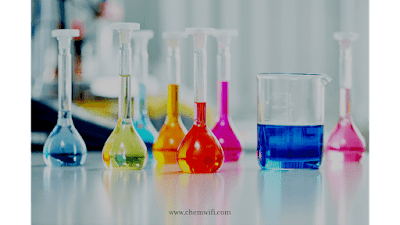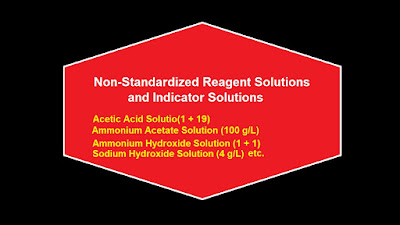Non-Standardized Reagent Solutions and Indicator Solutions
Acetic Acid Solution (1 + 19)
Dilute 50 mL of glacial acetic acid with 950 mL of water, and mix.
Ammonium Acetate Solution (100 g/L)
Dissolve 100 g of ammonium acetate (CH3COONH4) in about 750 mL of water, filter, and dilute to 1 L.
Ammonium Acetate—Acetic Acid Solution
Dissolve 100 g of ammonium acetate (CH3COONH4) in about 600 mL of water, filter, add 200 mL of glacial acetic acid to the filtrate, and dilute to 1 L with water.
Ammonium Hydroxide Solution (1 + 1)
Dilute 500 mL of ammonium hydroxide (NH4OH) with 500 mL of water, and mix.
Ammonium Molybdate—Sulfuric Acid Solution (50 g (NH4)6 Mo7O24·4H2O/L)—
Transfer 50 g of ammonium molybdate tetrahydrate toa1L flask, add 800 mL of 1 N H2SO4 shake to dissolve the salt, and dilute with 1 N H2SO4 to 1 L.
Ammonium Thiocyanate Solution (300 g/L)
Dissolve 300 g of ammonium thiocyanate (NH 4SCN) in about 750 mL of water, filter, and dilute to 1 L.
Barium Chloride Solution (120 g BaCl2·2H2O/L)
Dissolve 120 g of barium chloride dihydrate in about 750 mL of water, filter, and dilute to 1 L.
Bromine Water (Saturated)
To 1 L of water in a glass-stoppered bottle add bromine and shake until no more bromine is dissolved by the solution. Start with 10 mL of bromine. Keep a few drops of bromine on the bottom of the bottle, and use only the clear water solution.
Crystal Violet Indicator Solution (10 g/L)
Dissolve 1 g of crystal violet (hexamethyl-p-rosaniline chloride) in 100 mL of glacial acetic acid (CH3COOH, sp gr 1.05) and filter if necessary.
Ferric Ammonium Sulfate Indicator Solution (80 g FeNH4(SO4)2·12H2O/L)
Dissolve 80 g of clear crystals of ferric ammonium sulfate dodecahydrate in about 750 mL of water, filter, add a few drops of sulfuric acid (H2SO4), if necessary, to clear the solution, and dilute to 1 L.
Hydrogen Sulfide Solution (Saturated)
Saturate water with hydrogen sulfide gas by bubbling the gas through the water. The solution must be freshly prepared.
Hydroxylamine Hydrochloride Solution (100 g/L)
Dissolve 100 g of hydroxylamine hydrochloride (NH2OH·HCl) in about 600 mL of water, filter, and dilute to 1 L.
Hydroxylamine Hydrochloride Solution (300 g/L)
Dissolve 300 g hydroxylamine hydrochloride (NH2–OH·HCl) in about 600 mL of water, filter, and dilute to 1 L.
Mercuric Acetate Solution (25 g/L)
Dissolve 25 g of mercuric acetate (Hg(CH3COO)2) in about 500 mL of water, filter, and dilute to 1 L.
(Warning—Mercuric acetate is very
toxic if swallowed.)
toxic if swallowed.)
Mercuric Chloride Solution (50 g/L)
Dissolve 50 g
of mercuric chloride (HgCl2) in about 750 mL of water, filter,
and dilute to 1 L.
of mercuric chloride (HgCl2) in about 750 mL of water, filter,
and dilute to 1 L.
(Warning—Mercuric chloride is very toxic
if swallowed.)
if swallowed.)
Methyl Orange Indicator Solution (1 g/L)
Dissolve
0.1 g of methyl orange in 100 mL of water and filter if
necessary.
0.1 g of methyl orange in 100 mL of water and filter if
necessary.
Methyl Orange Indicator Solution, Modified (1
g/L)
Dissolve 0.1 g of methyl orange and 0.14 g of xylene
cyanole FF dye in 100 mL of water and filter if necessary.
cyanole FF dye in 100 mL of water and filter if necessary.
Methyl Red Indicator Solution (1 g/L)
Dissolve 1 g
of methyl red in 1 L of ethanol (95 %).
of methyl red in 1 L of ethanol (95 %).
Methyl Red Indicator Solution (5 g/L)
Dissolve 5 g
of methyl red in 1 L of ethanol (95 %)
of methyl red in 1 L of ethanol (95 %)
Osmium Tetroxide Solution (0.01 M) (in 0.1 N
H2SO4)
Dissolve 0.25 g of osmium tetroxide (OsO4) in 100
mL of 0.1 N H2SO4.
mL of 0.1 N H2SO4.
(Warning—The preparation of
the osmium tetroxide solution should be carried out in a
well-ventilated hood because of the poisonous and irritating
vapors given off by this compound.)
the osmium tetroxide solution should be carried out in a
well-ventilated hood because of the poisonous and irritating
vapors given off by this compound.)
1,10-Phenanthroline (o-Phenanthroline) Ferrous Sulfate Indicator Solution (0.025 M)
Dissolve 1.485 g of 1,10-
phenanthroline monohydrate in 100 mL of 0.025 M ferrous
sulfate solution. The 0.025 M ferrous sulfate solution is
prepared by dissolving 0.695 g of FeSO4·7H2O in 100 mL of
water.
phenanthroline monohydrate in 100 mL of 0.025 M ferrous
sulfate solution. The 0.025 M ferrous sulfate solution is
prepared by dissolving 0.695 g of FeSO4·7H2O in 100 mL of
water.
1,10-Phenanthroline (o-Phenanthroline) Indicator
Solution (3 g/L)
Dissolve 3 g of 1,10-phenanthroline monohydrate in 500 mL of water, add 1 mL of hydrochloric acid
(HCl), mix, filter, and dilute to 1 L.
(HCl), mix, filter, and dilute to 1 L.
Phenolphthalein Indicator Solution (10 g/L)
Dissolve 1 g of phenolphthalein in 100 mL of ethanol (95 %) (see Note 29), methanol, or isopropanol.
Phenolphthalein Indicator Solution in Pyridine (10
g/L)
Dissolve 1 g of phenolphthalein in pyridine and dilute
with pyridine to 100 mL.
with pyridine to 100 mL.
Potassium Iodide Solution (100 g/L)
Dissolve 100 g
of potassium iodide (KI) in about 750 mL of water, filter, and
dilute to 1 L.
of potassium iodide (KI) in about 750 mL of water, filter, and
dilute to 1 L.
Potassium Iodide Solution (300 g/L)
Dissolve 300 g
of potassium iodide (KI) in about 750 mL of water, filter, and
dilute to 1 L.
of potassium iodide (KI) in about 750 mL of water, filter, and
dilute to 1 L.
Silver Nitrate Solution (17 g/L)
Dissolve 17 g of
silver nitrate (AgNO3) in water, mix, dilute to 1 L, and store in
a light-resistant glass container.
silver nitrate (AgNO3) in water, mix, dilute to 1 L, and store in
a light-resistant glass container.
Sodium Diethyldithiocarbamate Solution (1 g/L)
Dissolve 1 g of sodium diethyldithiocarbamate in 750 mL of
water, filter if necessary, and dilute to 1 L.
water, filter if necessary, and dilute to 1 L.
Sodium Hydroxide Solution (4 g/L)
Dissolve 4 g of
sodium hydroxide (NaOH) in water and dilute to 1 L.
sodium hydroxide (NaOH) in water and dilute to 1 L.
Sodium Hydroxide Solution (40 g/L)
Dissolve 40 g
of sodium hydroxide (NaOH) in water and dilute to 1 L.
of sodium hydroxide (NaOH) in water and dilute to 1 L.
Stannous Chloride Solution (20 SnCl2·2H2O/L)
Dissolve 20 g of stannous chloride dihydrate in 500 mL of
hydrochloric acid (HCl), filter, if necessary, through a sintered glass filter, and dilute with HCl to 1 L.
hydrochloric acid (HCl), filter, if necessary, through a sintered glass filter, and dilute with HCl to 1 L.
Starch Indicator Solution (10 g/L)
Mix 1 g of
soluble starch with 5 mg of red mercuric iodide (HgI2) and
enough cold water to make a thin paste, and pour slowly, with
constant stirring, into 100 mL of boiling water. Boil the
mixture while stirring until a thin, translucent fluid is obtained.
Cool before use. (Warning—Mercuric iodide is very toxic if
swallowed.)
soluble starch with 5 mg of red mercuric iodide (HgI2) and
enough cold water to make a thin paste, and pour slowly, with
constant stirring, into 100 mL of boiling water. Boil the
mixture while stirring until a thin, translucent fluid is obtained.
Cool before use. (Warning—Mercuric iodide is very toxic if
swallowed.)
REAGENT TESTING SOLUTIONS
Standard Ion Solutions
Arsenic, Standard Solution (1 mL = 0.001 mg As)
Dissolve 0.1320 g of arsenic trioxide (As2O3) in 10 mL of sodium hydroxide solution (NaOH, 40 g/L),
neutralize with sulfuric acid (H2SO4, 1 + 15), add 10 mL of the
acid in excess, and dilute with water to 1 L. To 10 mL of this
solution (1 mL = 0.1 mg As) add 10 mL of H2SO4 (1 + 15), and
dilute with water to 1 L.
neutralize with sulfuric acid (H2SO4, 1 + 15), add 10 mL of the
acid in excess, and dilute with water to 1 L. To 10 mL of this
solution (1 mL = 0.1 mg As) add 10 mL of H2SO4 (1 + 15), and
dilute with water to 1 L.
Chloride, Standard Solution (1 mL = 0.005 mg Cl−
)
Dissolve 0.1650 g of sodium chloride (NaCl) in water, and
dilute to 1 L. Dilute 5 mL of this solution to 100 ml.
dilute to 1 L. Dilute 5 mL of this solution to 100 ml.
Iron, Standard Solution (1 mL = 0.01 mg Fe)
Dissolve 0.1 g of iron in 10 mL of hydrochloric acid (HCl,
1 + 1) and 1 mL of bromine water. Boil until the excess
bromine is removed. Add 200 mL of HCl, cool, and dilute to 1
L in a volumetric flask. Dilute 100 mL of this solution to 1 L.
1 + 1) and 1 mL of bromine water. Boil until the excess
bromine is removed. Add 200 mL of HCl, cool, and dilute to 1
L in a volumetric flask. Dilute 100 mL of this solution to 1 L.
Alternative Method—As an alternative, the standard
iron solution may be prepared by weighing exactly 0.7022 g of
ferrous ammonium sulfate hexahydrate
(FeSO4·(NH4)2SO4·6H2O, minimum purity, 99.5 %), dissolving in 500 mL of water containing 20 mL of sulfuric acid
(H2SO4, sp gr 1.84) and diluting to 1 L with water. Dilute 100
mL of this solution to 1 L.
iron solution may be prepared by weighing exactly 0.7022 g of
ferrous ammonium sulfate hexahydrate
(FeSO4·(NH4)2SO4·6H2O, minimum purity, 99.5 %), dissolving in 500 mL of water containing 20 mL of sulfuric acid
(H2SO4, sp gr 1.84) and diluting to 1 L with water. Dilute 100
mL of this solution to 1 L.
Lead, Standard Solution (1 mL = 0.01 mg Pb)
Dissolve 0.160 g of lead nitrate (Pb(NO3)2) in 100 mL of nitric
acid (HNO3, 1 + 99), and dilute to 1 L. Dilute 10 mL of this
solution with HNO3 (1 + 99) to 100 ml. Prepare the dilute
solution immediately before use.
acid (HNO3, 1 + 99), and dilute to 1 L. Dilute 10 mL of this
solution with HNO3 (1 + 99) to 100 ml. Prepare the dilute
solution immediately before use.
Mercury, Standard Solution (1 mL = 0.05 mg Hg)
Dissolve 1.35 g of mercuric chloride (HgCl2) in water, add 8 mL of HCl, and dilute to 1 L. To 50 mL of this solution (1
mL = 1 mg Hg) add 8 mL of HCl, and dilute to 1 L.
mL = 1 mg Hg) add 8 mL of HCl, and dilute to 1 L.
( Warning—Mercuric chloride is very toxic if swallowed.)
Sulfate, Standard Solution (1 mL = 0.01 mg SO4
−−)
Dissolve 0.148 g of anhydrous sodium sulfate (Na2SO4) in
water, and dilute to 100 ml. Dilute 10 mL of this solution to 1
L.
water, and dilute to 100 ml. Dilute 10 mL of this solution to 1
L.

